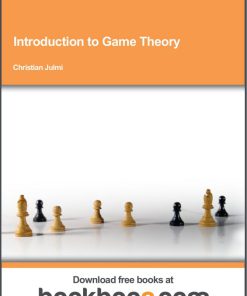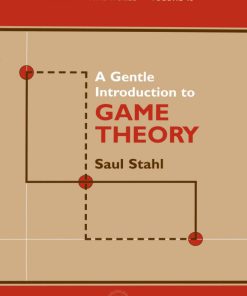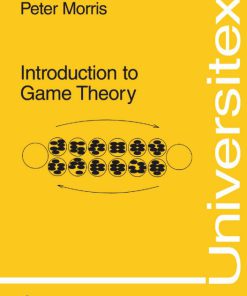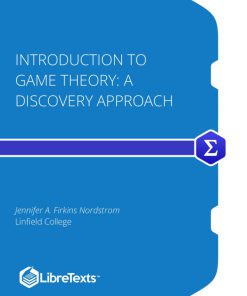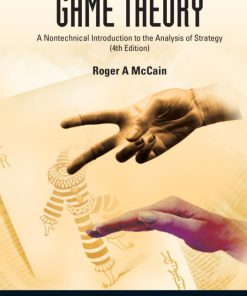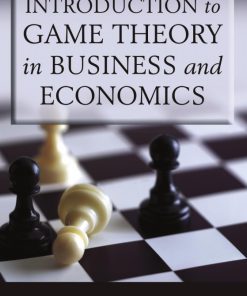Introduction to Game Theory 2004 1st edition by Martin Osborne 0197583067 9780197583067
$50.00 Original price was: $50.00.$25.00Current price is: $25.00.
Authors:Martin J. Osborne , Series:Gaming [182] , Author sort:Osborne, Martin J. , Languages:Languages:eng , Published:Published:Oct 2021 , Publisher:Open University Press
Introduction to Game Theory 2004 1st edition by Martin J. Osborne – Ebook PDF Instant Download/DeliveryISBN: 0197583067 9780197583067
Full download Introduction to Game Theory 2004 1st edition after payment.
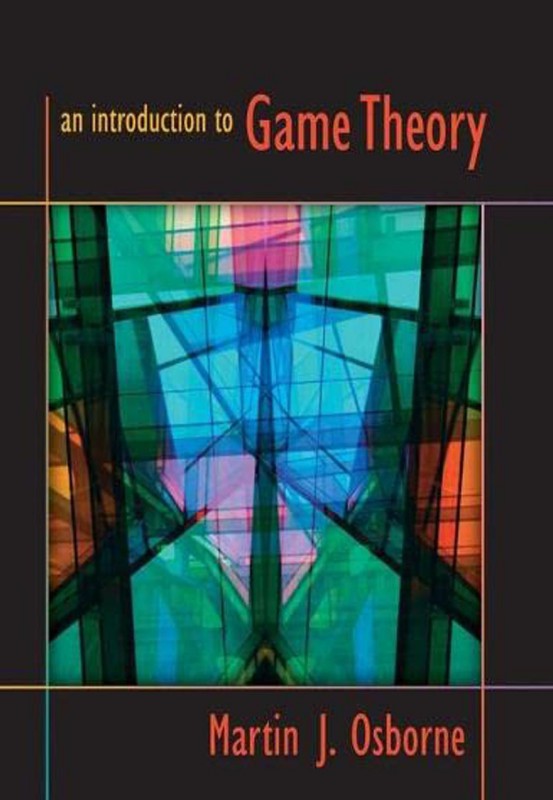
Product details:
ISBN-10 : 0197583067
ISBN-13 : 9780197583067
Author : Martin J. Osborne
Game-theoretic reasoning pervades economic theory and is used widely in other social and behavioral sciences. An Introduction to Game Theory, by Martin J. Osborne, presents the main principles of game theory and shows how they can be used to understand economic, social, political, and biological phenomena. The book introduces in an accessible manner the main ideas behind the theory rather than their mathematical expression. All concepts are defined precisely, and logical reasoning is used throughout. The book requires an understanding of basic mathematics but assumes no specific knowledge of economics, political science, or other social or behavioral sciences. Coverage includes the fundamental concepts of strategic games, extensive games with perfect information, and coalitional games; the more advanced subjects of Bayesian games and extensive games with imperfect information; and the topics of repeated games, bargaining theory, evolutionary equilibrium, rationalizability, and maxminimization. The book offers a wide variety of illustrations from the social and behavioral sciences and more than 280 exercises. Each topic features examples that highlight theoretical points and illustrations that demonstrate how the theory may be used. Explaining the key concepts of game theory as simply as possible while maintaining complete precision, An Introduction to Game Theory is ideal for undergraduate and introductory graduate courses in game theory.
Introduction to Game Theory 2004 1st Table of contents:
1 Introduction
1.1 What is game theory?
An outline of the history of game theory
John von Neumann
1.2 The theory of rational choice
1.3 Coming attractions: interacting decisionmakers
Notes
I Games with Perfect Information
2 Nash Equilibrium: Theory
2.1 Strategic games
2.2 Example: the Prisoner’s Dilemma
2.3 Example: Bach or Stravinsky?
2.4 Example: Matching Pennies
2.5 Example: the Stag Hunt
2.6 Nash equilibrium
John F. Nash, Jr.
Studying Nash equilibrium experimentally
2.7 Examples of Nash equilibrium
Experimental evidence on the Prisoner’s Dilemma
Focal points
2.8 Best response functions
2.9 Dominated actions
2.10 Equilibrium in a single population: symmetric games and symmetric equilibria
Notes
3 Nash Equilibrium: Illustrations
3.1 Cournot’smodel of oligopoly
3.2 Bertrand’s model of oligopoly
Cournot, Bertrand, and Nash: some historical notes
3.3 Electoral competition
3.4 The War of Attrition
3.5 Auctions
Auctions from Babylonia to eBay
3.6 Accident law
Notes
4 Mixed Strategy Equilibrium
4.1 Introduction
Some evidence on expected payoff functions
4.2 Strategic games in which players may randomize
4.3 Mixed strategy Nash equilibrium
4.4 Dominated actions
4.5 Pure equilibria when randomization is allowed
4.6 Illustration: expert diagnosis
4.7 Equilibrium in a single population
4.8 Illustration: reporting a crime
Reporting a crime: social psychology and game theory
4.9 The formation of players’ beliefs
4.10 Extension: finding all mixed strategy Nash equilibria
4.11 Extension: games in which each player has a continuum of actions
4.12 Appendix: representing preferences by expected payoffs
Notes
5 Extensive Games with Perfect Information: Theory
5.1 Extensive games with perfect information
5.2 Strategies and outcomes
5.3 Nash equilibrium
5.4 Subgame perfect equilibrium
5.5 Finding subgame perfect equilibria of finite horizon games: backward induction
Ticktacktoe, chess, and related games
Notes
6 Extensive Games with Perfect Information: Illustrations
6.1 The ultimatum game, the holdup game, and agenda control
Experiments on the ultimatum game
6.2 Stackelberg’s model of duopoly
6.3 Buying votes
6.4 A race
Notes
7 Extensive Games with Perfect Information: Extensions and Discussion
7.1 Allowing for simultaneous moves
More experimental evidence on subgame perfect equilibrium
7.2 Illustration: entry into a monopolized industry
7.3 Illustration: electoral competition with strategic voters
7.4 Illustration: committee decisionmaking
7.5 Illustration: exit froma declining industry
7.6 Allowing for exogenous uncertainty
7.7 Discussion: subgame perfect equilibrium and backward induction
Experimental evidence on the centipede game
Notes
8 Coalitional Games and the Core
8.1 Coalitional games
8.2 The core
8.3 Illustration: ownership and the distribution of wealth
8.4 Illustration: exchanging homogeneous horses
8.5 Illustration: exchanging heterogeneous houses
8.6 Illustration: voting
8.7 Illustration: matching
Matching doctors with hospitals
8.8 Discussion: other solution concepts
Notes
II Games with Imperfect Information
9 Bayesian Games
9.1 Motivational examples
9.2 General definitions
9.3 Two examples concerning information
9.4 Illustration: Cournot’s duopoly game with imperfect information
9.5 Illustration: providing a public good
9.6 Illustration: auctions
Auctions of the radio spectrum
9.7 Illustration: juries
9.8 Appendix: auctions with an arbitrary distribution of valuations
Notes
10 Extensive Games with Imperfect Information
10.1 Extensive games with imperfect information
10.2 Strategies
10.3 Nash equilibrium
10.4 Beliefs and sequential equilibrium
10.5 Signaling games
10.6 Illustration: conspicuous expenditure as a signal of quality
10.7 Illustration: education as a signal of ability
10.8 Illustration: strategic information transmission
10.9 Illustration: agenda control with imperfect information
Notes
III Variants and Extensions
11 Strictly Competitive Games and Maxminimization
11.1 Maxminimization
11.2 Maxminimization and Nash equilibrium
11.3 Strictly competitive games
11.4 Maxminimization and Nash equilibrium in strictly competitive games
Maxminimization: some history
Empirical tests: experiments, tennis, and soccer
Notes
12 Rationalizability
12.1 Rationalizability
12.2 Iterated elimination of strictly dominated actions
12.3 Iterated elimination of weakly dominated actions
12.4 Dominance solvability
Notes
13 Evolutionary Equilibrium
13.1 Monomorphic pure strategy equilibrium
13.2 Mixed strategies and polymorphic equilibrium
13.3 Asymmetric contests
Side-blotched lizards
13.4 Variation on a theme: sibling behavior
Explaining the outcomes of contests in nature
13.5 Variation on a theme: the nesting behavior of wasps
13.6 Variation on a theme: the evolution of the sex ratio
Notes
14 Repeated Games: The Prisoner’s Dilemma
14.1 The main idea
14.2 Preferences
14.3 Repeated games
14.4 Finitely repeated Prisoner’s Dilemma
14.5 Infinitely repeated Prisoner’s Dilemma
14.6 Strategies in an infinitely repeated Prisoner’s Dilemma
14.7 Some Nash equilibria of an infinitely repeated Prisoner’s Dilemma
14.8 Nash equilibrium payoffs of an infinitely repeated Prisoner’s Dilemma
Experimental evidence
14.9 Subgame perfect equilibria and the one-deviation property
Axelrod’s tournaments
14.10 Some subgame perfect equilibria of an infinitely repeated Prisoner’s Dilemma
Reciprocal altruismamong sticklebacks
14.11 Subgame perfect equilibrium payoffs of an infinitely repeated Prisoner’s Dilemma
Medieval trade fairs
14.12 Concluding remarks
Notes
15 Repeated Games: General Results
15.1 Nash equilibria of general infinitely repeated games
15.2 Subgame perfect equilibria of general infinitely repeated games
15.3 Finitely repeated games
15.4 Variation on a theme: imperfect observability
Notes
16 Bargaining
16.1 Bargaining as an extensive game
16.2 Illustration: trade in amarket
16.3 Nash’s axiomatic model
16.4 Relation between strategic and axiomatic models
Notes
17 Appendix: Mathematics
17.1 Numbers
17.2 Sets
17.3 Functions
17.4 Profiles
17.5 Sequences
17.6 Probability
17.7 Proofs
People also search for Introduction to Game Theory 2004 1st:
strategy an introduction to game theory
an introduction to game theory by martin j osborne
strategy an introduction to game theory pdf
games and information an introduction to game theory
a very short introduction to game theory
You may also like…
eBook PDF
STRATEGY AN INTRODUCTION TO GAME THEORY 1st edition by Joel Watson 0393904067 9780393904062
eBook PDF
Introduction to Game Theory a Discovery Approach 1st edition by Jennifer Firkins Nordstrom





